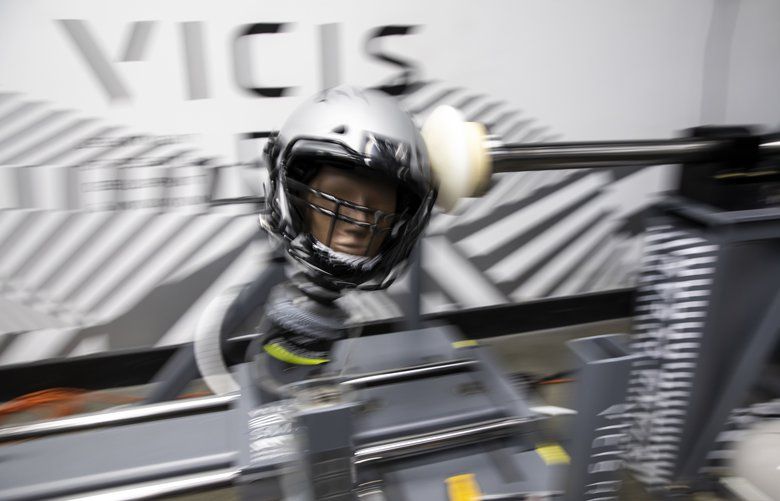U.S. Route 36 extends for more than 200 miles through the midsection of Colorado. In the center of the state, it’s better known as the Denver-Boulder Turnpike, providing scenic views of the Flatirons to the northwest and downtown Denver to the southeast.
Given the potentially groundbreaking research underway at each end, a more appropriate moniker for the turnpike might be Head Trauma Highway.
At one end, University of Colorado-Boulder researchers are using Virtual Reality to study the body’s response to concussion.
At the other, 30 miles away, University of Colorado-Denver engineers are reinventing the helmet using a shock-absorbing, rubber-like substance known as liquid crystal elastomer (LCE).
VR and LCEs, concussion prevention and recovery, two campuses and one vexing issue— it’s all part of CU’s ongoing attempt to solve the mystery of head trauma.
“What we’re doing isn’t creative, it’s proactive,” Buffaloes athletic director Rick George said. “We’ve got some passionate faculty, and the (Pac-12) has given us an opening.”
The concurrent but independent research projects are funded by the Pac-12’s Student Athlete Health and Well-Being Initiative (SAHWBI), which was created by commissioner Larry Scott in 2013 with approval by the presidents and chancellors.
Using a sliver of its windfall from the College Football Playoff, the conference has allocated $3.6 million annually ($300,000 per school) to supporting research projects designed to improve the welfare of athletes during and after their playing careers.
Many of the current projects focus on mental health and head trauma. Colorado has taken a leading role in both areas, but particularly the latter.
Faculty members realized years ago — back when concussions in football were just entering the public realm— that medical research was a way to “bridge the gap that existed between the faculty and athletics,” according to Miguel Rueda, a senior associate athletic director for health and performance.
“We started with smaller projects,” Rueda added, “and when concussions came up, we thought, ‘We could actually do something with this.’
“I don’t think there will be an answer where we can eliminate concussions altogether, but (there are ways) to make the sport safer.”
The Boulder-based initiative was the first of the turnpike’s tandem to receive funding from the conference, in 2016. Led by Matthew McQueen, an associate professor for integrative physiology, the multi-year project is designed to standardize the data collection process that occurs on each campus when athletes sustain head trauma.
Five schools were involved in the initial phase. Colorado, Utah, Washington, USC and Oregon State agreed to share concussion data during the 2018-19 school year in at least seven sports, including football. (Eventually, every school will participate.)
McQueen and his team “captured” over 100 incidents of concussion, and each athlete was evaluated in precisely the same manner regardless of gender, age or sport. The data showed concussions symptoms typically resolved themselves within 10 days.
“A lot of the patterns were consistent with what’s reported in the literature,’’ McQueen said, “and we’re seeing that in women’s sports, not just football. This is a student-athlete issue.”
The next step is to add Virtual Reality to the process, in the form of eye-tracking goggles designed by SyncThink, a Palo-Alto company.
The goggles measure ocular motor efficiency by moving a red dot in a circular pattern. While the eyes track the dot, infrared cameras within the goggles track the accuracy of the eye movement.
Medical personnel then compare an athlete’s baseline score (measured in a healthy state) to the post-collision score. The degree of variance determines whether a concussion is present and, if so, to what degree.
McQueen hopes to fuse the observational data collected by athletic department trainers and doctors with the eye-tracking scores next summer and begin to draw conclusions.
“Tracking is a quantified way of studying it,” he said.
Meanwhile, at the other end of the turnpike, the focus is on the helmet. Just not the visible part.
For years, concussion researchers have devoted more resources to the shape and design of the outer shell, at the expense of the internal structure — the padding.
The CU-Denver team, led by Chris Yakacki, an associate professor of mechanical engineering, has turned helmet study on its head with the help of polymers.
Polymers are substances of similar molecules that can be used to form synthetics, such as nylon or Teflon. The polymer involved in revolutionizing football helmets is a foam-rubber substance called liquid crystal elastomer (LCE).
For decades, LCEs were “stuck in academic labs” because of the painstaking nature of development, Yakacki explained. “You’d spent three weeks making something the size of a fingernail.”
Yakacki, who attended CU football games as a student, is fascinated by materials and sports medicine. LCEs are at the intersection of those passions. He patented a process by which LCEs can be manufactured quickly on a large scale — enough in two days, for instance, to create the foam filling for the padding on the inside of a helmet.
“We’re not trying to redesign the helmet,’’ said Yakacki, whose company, Impressio, has also received a research grant from the NFL.
“We take the old material, take out the foam and replace it with our material. You can’t see any difference (in the outer shell).
“I’d love it if people didn’t even know our material is inside.’’
Filled with LCEs, which bend and stretch like rubber, the restructured interior padding is intended to serve as a shock absorber.
Yakacki’s study is unfolding digitally and actually:
• A computer modeling program handed down by the NFL allows the researchers to simulate collisions on a virtual helmet injected with LCEs.
• The physical tests come courtesy of a pneumatic ram machine that hammers a real LCE-injected helmet.
The results will be shared with the Pac-12.
“Will there ever be the day when there are zero concussions in football?” Yakacki said. “I would ask that of any other sport.
“But we know a lot more because of the spotlight that’s been placed on the issue. It’s good. It has accelerated the research.
“Concussions aren’t just a football problem. We want to make the best helmet, whether it’s protecting someone when they’re tackled or falling off their bike.”


The opinions expressed in reader comments are those of the author only and do not reflect the opinions of The Seattle Times.